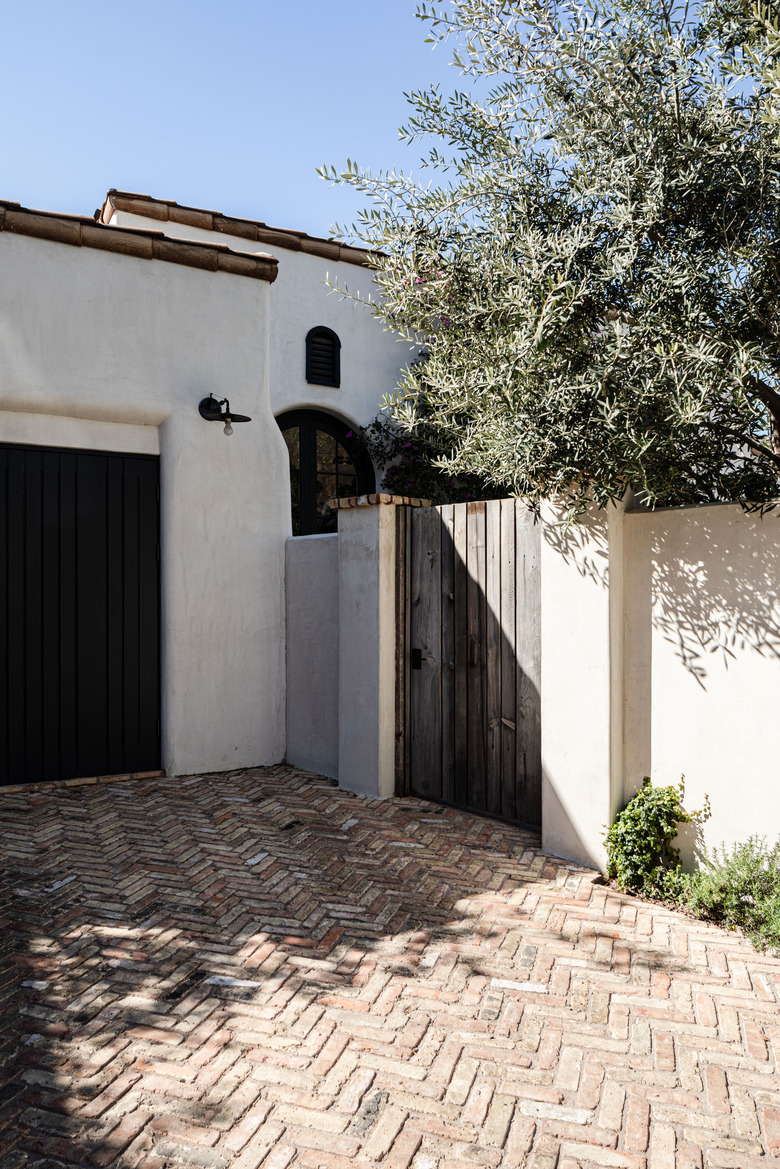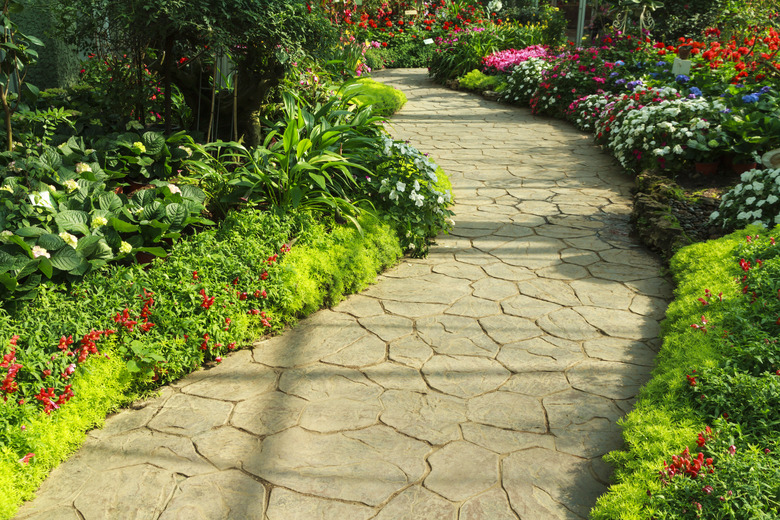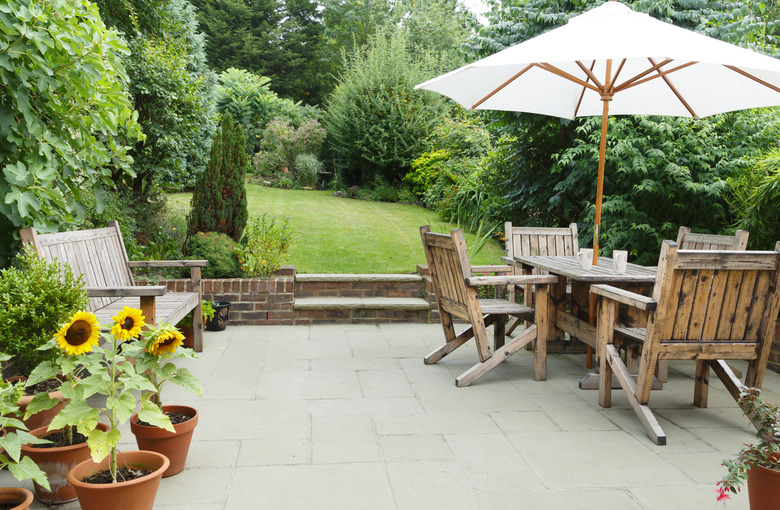Laying Patio Pavers Over Existing Concrete
One way to spruce up an existing concrete patio or pool deck that has seen better days is to cover it with patio pavers, and if you're considering listing your property for sale, it's an easy DIY way to pump up the curb appeal. You can even lay pavers on an asphalt surface such as a driveway, says Belgard, and if you use the right installation method, the pavers can even support vehicles.
Installing patio pavers is a great way to spruce up an old, sun-worn concrete patio but not one that has cracked or crumbled. If the substrate under the pavers isn't stable, it won't be long before the pavers themselves crack or move out of alignment. If your concrete slab is in good shape, though, you can install the pavers on a bed of sand, or you can use mortar to adhere them, and you'll give your old concrete patio a whole new look.
Evaluating Existing Concrete as a Paver Base
Evaluating Existing Concrete as a Paver Base
Although a concrete pad has to be in good condition to serve as a paver base for patio pavers, it doesn't have to be perfect. Some amount of roughness or spalling is acceptable if you plan to lay the pavers on a bed of sand because the sand will fill these imperfections. If you prefer to set the pavers in mortar, you'll want to consider filling spalls and other irregularities with a concrete resurfacer to make sure the pavers have a level surface to which the mortar can adhere.
Look for cracks — Crumbled sections and cracks, especially spreading ones, are bad signs that indicate settling or instability in the soil, and paver installation on a concrete pad with these problems is not a good idea.
Check drainage — It's important for the slab to have sufficient slope for water to drain off, or it will just collect underneath the pavers and undermine them. If you're planning to install pavers on an old patio next to the house, make sure water drains away from the house, not toward it. If your existing concrete pad slopes toward the house and correcting the slope isn't practical, Landscape Design Advice recommends cutting away a lengthwise section along the house and installing a perforated drainage pipe as an alternative.
Prepare for a height change — Concrete and brick pavers will add about 3 inches of height to the surface of your patio, creating a problem at transitions to other surfaces, at stairways and in doorways. Moreover, it could bring the finished surface too close to your home's siding to satisfy the building codes. You can't always compensate for this height change, and when you can't, you can always choose thin pavers made of flagstone or some other material, but resurfacing the old concrete might be a better option than laying paving stones.
What to Do About Edging
What to Do About Edging
A surface covered with patio pavers needs a raised edge to keep the pavers in place. You can line the perimeter of the concrete pad with bender board or a similar wood edging, or you can install a product such as ProFlex edging. You butt this product against the edge of the pad and drive spikes into the ground to hold it in place, and it provides a stable border.
An alternative that is more secure and looks better is to mortar the outside row of border pavers to the concrete, which is something you can do even if you lay the rest of the pavers on sand. You can use decorative granite edging pavers to give the patio a more sophisticated appearance, you can use brick edgers or you can simply use the same pavers you use for the rest of the patio.
Whichever edging material you use, don't forget to incorporate drainage outlets at the points toward which water flows. These holes must be kept clear to give the water someplace to go.
Installing Patio Pavers on a Sand Bed
Installing Patio Pavers on a Sand Bed
If you're going to install your patio pavers on sand, the edging has to be in place before you spread the sand. Marvin's Brick Pavers recommends spreading coarse sand to a depth of 1/2 to 1 inch. If the concrete is flat and in good condition, the sand should be easy to screed level using a length of 1x6 or 2x6 lumber.
If you want to extend the dimensions of the patio, now is a good time to do it. Simply dig out the area you want to pave, making it deep enough to hold a 2- to 3-inch bed of gravel and sand, install edging around the expanded patio and tamp the sand level with the sand on the concrete pad. There's actually nothing preventing you from setting the pavers in these two sections at different levels to create a split-level patio, but avoid transitions with height differences that are too small to notice, as these are are tripping hazards.
After you lay pavers, you cover the entire patio with polymeric sand and work it into the gaps between the pavers. It helps to hold them in place and helps direct water runoff from the patio.
Mortaring Pavers to Existing Concrete
Mortaring Pavers to Existing Concrete
Mortar provides a permanent bond and extra stability for pavers on a concrete patio, but you shouldn't use it to cover an asphalt surface because asphalt is flexible and can move, and that cracks the mortar. Latex-modified mortar, similar to what you use to lay tiles, provides good bond strength, sets quickly and is flexible enough to withstand microscopic movements of the slab.
Laying pavers with mortar is similar to laying tiles. You butter the underside, one end and one side of each paver with about 1/2 inch of mortar and set it in place. When you set the next paver, which has been similarly mortared, the mortar fills the gap between the pavers much like grout. Mortar stiffens quickly, and when it does, you use a stiff brush to clean off the excess. One disadvantage of mortar is that it needs to be sealed when it cures to prevent moisture penetration and deterioration.
Cost of Demolishing the Pad and Starting Over
Cost of Demolishing the Pad and Starting Over
Laying pavers directly on a concrete patio is not without its drawbacks. The added height can be a problem, and an existing concrete patio in questionable condition can lead to damaged pavers in just a few years. In the back of your DIY mind, you might be wondering how much more it would cost to demolish the patio and lay the pavers on a new base of gravel and sand.
The main extra cost is having the pad broken up and carted away. Once it's gone, you'll have a predug bed for the pavers, although you'll probably have to deepen it a few inches to make room for gravel and sand, and that will cost extra if you don't do the work yourself.
Hometown Demolition quotes the price for pad demolition as $1 to $3 per square foot depending on where you live and the feasibility of using heavy equipment. You'll pay top dollar to remove a patio if the job has to be done by hand, but you may consider that a small price if a professional-looking transformation of your outdoor living space is a top priority.
References
- Belgard: Laying Pavers Over Concrete or Asphalt
- Landscape Design Advice: Existing Concrete Patio Slopes Towards House
- Marvin's Brick Pavers: Paver Installation On Top Of Existing Concrete Slab is Possible
- Today's Homeowner: How to Install Pavers Over a Concrete Patio Without Mortar
- Hometown Demolition: How Much Does It Cost to Demolish a Concrete Driveway?


